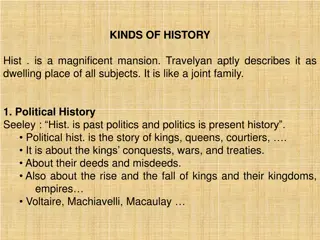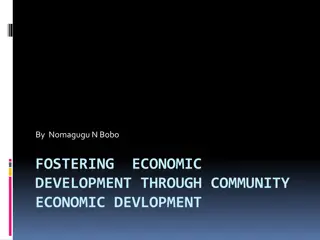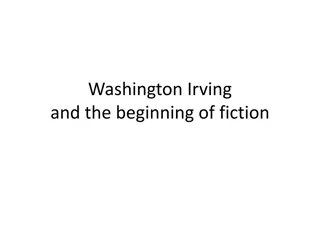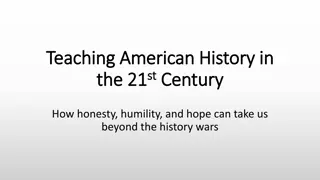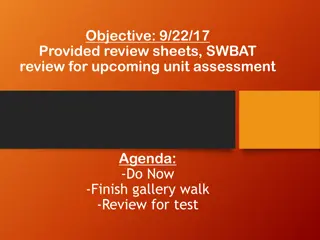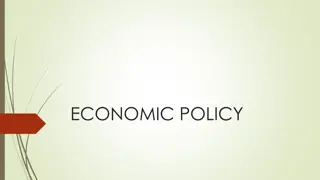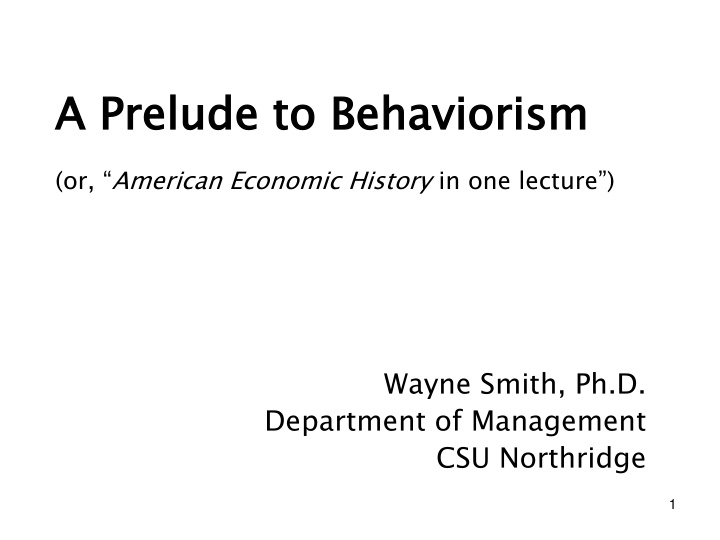
Management Transitions and Key Trends in Economic History
Explore the evolution of management transitions from agrarian to service economies, with insights on key economic trends since 1875, including labor immigration, urbanization, and division of labor.
Uploaded on | 4 Views
Download Presentation

Please find below an Image/Link to download the presentation.
The content on the website is provided AS IS for your information and personal use only. It may not be sold, licensed, or shared on other websites without obtaining consent from the author. If you encounter any issues during the download, it is possible that the publisher has removed the file from their server.
You are allowed to download the files provided on this website for personal or commercial use, subject to the condition that they are used lawfully. All files are the property of their respective owners.
The content on the website is provided AS IS for your information and personal use only. It may not be sold, licensed, or shared on other websites without obtaining consent from the author.
E N D
Presentation Transcript
A Prelude to Behaviorism A Prelude to Behaviorism (or, American Economic History in one lecture ) Wayne Smith, Ph.D. Department of Management CSU Northridge 1
The Fall of the Roman Empire Management Dimension Example Characteristic Increasing urbanization operates very differently than agriculture Formal processes doesn t always guarantee cultural integration Emperors learned the hard way about keeping friends close and keeping enemies closer Learned the hard way about the limits of centralized rule Outsourcing military engagement to mercenaries is not sustainable Couldn t manage inflation of increasingly non-silver coins Couldn t manage increasingly far- flung borders Planning Leading Organizing Controlling 3
Etymology of Management The Agrarian revolution preceded the Industrial Revolution The earliest organizations were farms (zoo) The most important animal on the farm (organization) is the horse (professional). A human (manager) is in charge The English word manage is derived from the Italian word (maneggiare) for handling a horse which in turn is derived from the Latin word (manus) for hand , or in the context of management and leadership, to lead by hand. Source: Oxford English Dictionary How did we get to where we are now?...and how will you get to where you ll be in the future (i.e., your professional life)? 4
Transitions since ~1875 Agricultural Economy Manufacturing Economy Service Economy 5
Management Transitions Manufacturing Agriculture Service weather adapt to markets and economies extrinsic needs predict change in labor and capital intrinsic needs Planning by land size Leading cooperatives/ guilds/family/ children physical distance/ no other choices mostly hierarchies (one-to-many) wage/piecework /choice between factory work and school mostly networks (many-to-many) Organizing salary/bonus/ feedback/ continuous learning Controlling 6
2050 1875 1900 1925 1950 1975 2000 2025 Transition Agricultural Manufacturing Key Trends in (Social) Labor Immigration (especially from Europe) Urbanization (in large cities) Public Education (K-12) Key Trends in (Economic) Capital Division of Labor Optimize for efficiency by concentrating resources in a firm within a sector Specialization Coordination Industrial Machines Large-scale plant and equipment for mass production Standardization Training/Education Productivity Motivation/Incentives Financial Markets The sale price for a crop is set before it is sowed; Stocks sold to investors Forecasting Decision-making, Strategy Impact on Management (Classical Approaches) How do we do the thing right (efficiency)? Scientific Management, Administrative Principles, Bureaucratic Org. s 7
2050 1875 1900 1925 1950 1975 2000 2025 Transition Manufacturing Service Key Trends in (Social) Labor Gender (females in the workforce) Public Education (college and diversity) Professional Careers (including certifications) Key Trends in (Economic) Capital Scope of Goods and Services Global Markets (employees, customers, and suppliers) Diversity Culture Scale of Firms Optimize for stability in large organizations Size Leadership Complexity Control Systems Careers Specialist Professionals professionals and Generalist Managers Workplace livelihood Human Resources/Organizational Design Impact on Management (Behavioral Approaches) How do we do the right thing (effectiveness)? Communities/Human Needs, Personality/Adult Learning, Theory X/Y 8
2050 1875 1900 1925 1950 1975 2000 2025 Transition Service ? Key Trends in (Social) Labor Surrogate family Even more Diversity Key Trends in (Economic) Capital Knowledge Complexity Cooperation Teams Negotiation Conflict Resolution Environment, Sustainability, and Governance Accountability Ethics, Corporate Social Responsibility Rapid Change Continuous Innovation Communication Management Science (Operations Research) Approach Can we model (first we analyze, and then we automate) all inputs, processes, and outputs (i.e., optimize one or more processes)? Contingency Approach We focus on the behavioral approach but the dirty little secret is Successful managers apply all of these management approaches as needed to best effect an organizational outcome 9
The New Industrial Revolution (hint: these positions all need management) 15 California Community Colleges plan to offer Bachelor s Degrees beginning in Fall, 2017. Airframe manufacturing technology, Antelope Valley College Industrial automation, Bakersfield College Emergency services and allied health systems, Crafton Hills College Mortuary science, Cypress College Equine industry, Feather River College Dental hygiene, Foothill College and West Los Angeles College Bio-manufacturing, Mira Costa College Respiratory care, Modesto Junior College and Skyline College Automotive technology, Rio Hondo College Health information management, Mesa College Occupational studies, Santa Ana College Interaction design, Santa Monica College Health information management, Shasta College 10
Personal Competencies for Professional Success Lominger Standard 67 competencies Action Oriented; Dealing with Ambiguity; Approachability; Boss Relationships; Business Acumen; Career Ambition; Caring About Direct Reports; Comfort Around Higher Management; Command Skills; Compassion; Composure; Conflict Management; Confronting Direct Reports; Creativity; Customer Focus; Timely Decision Making; Decision Quality; Delegation; Developing Direct Reports and Others; Directing Others; Managing Diversity; Ethics and Values; Fairness to Direct Reports; Functional/Technical Skills; Hiring and Staffing; Humor; Informing; Innovation Management; Integrity and Trust; Intellectual Horsepower; Interpersonal Savvy; Learning on the Fly; Listening; Managerial Courage; Managing and Measuring Work; Negotiating; Organizational Agility; Organizing; Dealing With Paradox; Patience; Peer Relationships; Perseverance; Personal Disclosure; Personal Learning; Perspective; Planning; Political Savvy; Presentation Skills; Priority Setting; Problem Solving; Process Management; Drive for Results; Self-Development; Self-Knowledge; Sizing Up People; Standing Alone; Strategic Agility; Managing Through Systems; Building Effective Teams; Technical Learning; Time Management; Total Work Systems; Understanding Others; Managing Vision and Purpose; Work/Life Balance; Written Communication 11
Personal Competencies for Managerial Success All competencies are important, but a few competencies characterize the key differences between professionals and managers. These are relatively indifferent to country, economy, industry, firm, salary, rank, seniority, etc. Ethics and Values; Integrity and Trust; Compassion; Managing Diversity; Successful managers know that trust is thetrue organizational currency. Action Oriented; Command Skills; Managerial Courage; Standing Alone; Successful managers shrewdly demonstrate a bias towards action. Interpersonal Savvy; Organizational Agility; Political Savvy; Creativity; Successful managers have behavioral flexibility to adapt to reach any goal. Developing Relationships with Bosses, Direct Reports, and Peers; Successful managers are constantly cultivating and nurturing relationships. Managing Through Systems; Personal Learning; Successful managers are the best at self-initiated learning, and the best at visualizing invisible structures in entire organizational ecosystems. Tolerance for Ambiguity; Dealing With Paradox; Conflict Management; Successful managers thrive in environments of uncertainty. e.g, Non-routine decision-making; unclear goals, tasks, and outcomes; role conflict12
A Story I have a friend 13
Figure 1.5 Four functions of management Figure 1.5 Four functions of management
M MINTZBERG INTZBERG S S 10 M 10 MANAGERIAL ANAGERIAL R ROLES OLES
Tolerance for Ambiguity (How do we deal with it?) 16
References The Professional Competencies were adapted and excerpted from the Lominger Standards (now owned by Korn-Ferry International) : https://www.udemy.com/blog/lominger-competencies/ The Mintzberg s10 Managerial Roles and Organizations slides were excerpted from: Schermerhorn, J., and Bachrach, D. (2015) Management Skills 13th ed., Wiley. The Tolerance for Ambiguity slides were excerpted from: Whetton, D., and Cameron, K. (2011) Developing Management Skills 8th ed., Pearson. 17







